When Lightning Strikes: The Hidden Danger to Your Electronics
The skies darken, thunder rumbles, and suddenly—a brilliant flash illuminates everything. While lightning can be awe-inspiring to watch from a safe distance, it poses a serious threat to your home’s electrical systems and expensive electronics.
Lightning causing power surges is nature’s version of an electrical tsunami. When lightning strikes near your home or directly hits power lines, it introduces a massive voltage spike that can silently travel through your electrical system, overwhelming and destroying unprotected devices in the blink of an eye.
I’ve seen how these powerful surges can devastate homes across Texas. Let me walk you through what happens and why it matters to your property.
A typical lightning bolt isn’t just bright—it’s incredibly powerful, carrying approximately 300 million volts and 30,000 amps of current. To put that in perspective, your standard household outlet delivers just 120 volts. This explains why lightning causing power surges can be so destructive to anything connected to your electrical system.
These dangerous surges can enter your home through three main pathways:
Direct strikes occur when lightning hits power lines or your building directly, sending an overwhelming electrical current straight into your wiring. These are the most obviously destructive.
Inductive coupling happens when lightning strikes nearby, creating powerful electromagnetic fields that induce voltage in your home’s wiring—even without a direct hit. This is why a strike a mile away can still damage your electronics.
Ground potential rise occurs when lightning hits the ground near your home, causing the local ground voltage to spike dramatically. Since your electrical system is grounded, this creates a pathway for surge current to enter.
What many homeowners don’t realize is that these surges don’t just travel through electrical wiring—they can enter through phone lines, cable TV connections, internet cables, and even metal plumbing pipes. Your entire home becomes an interconnected network of potential surge pathways.
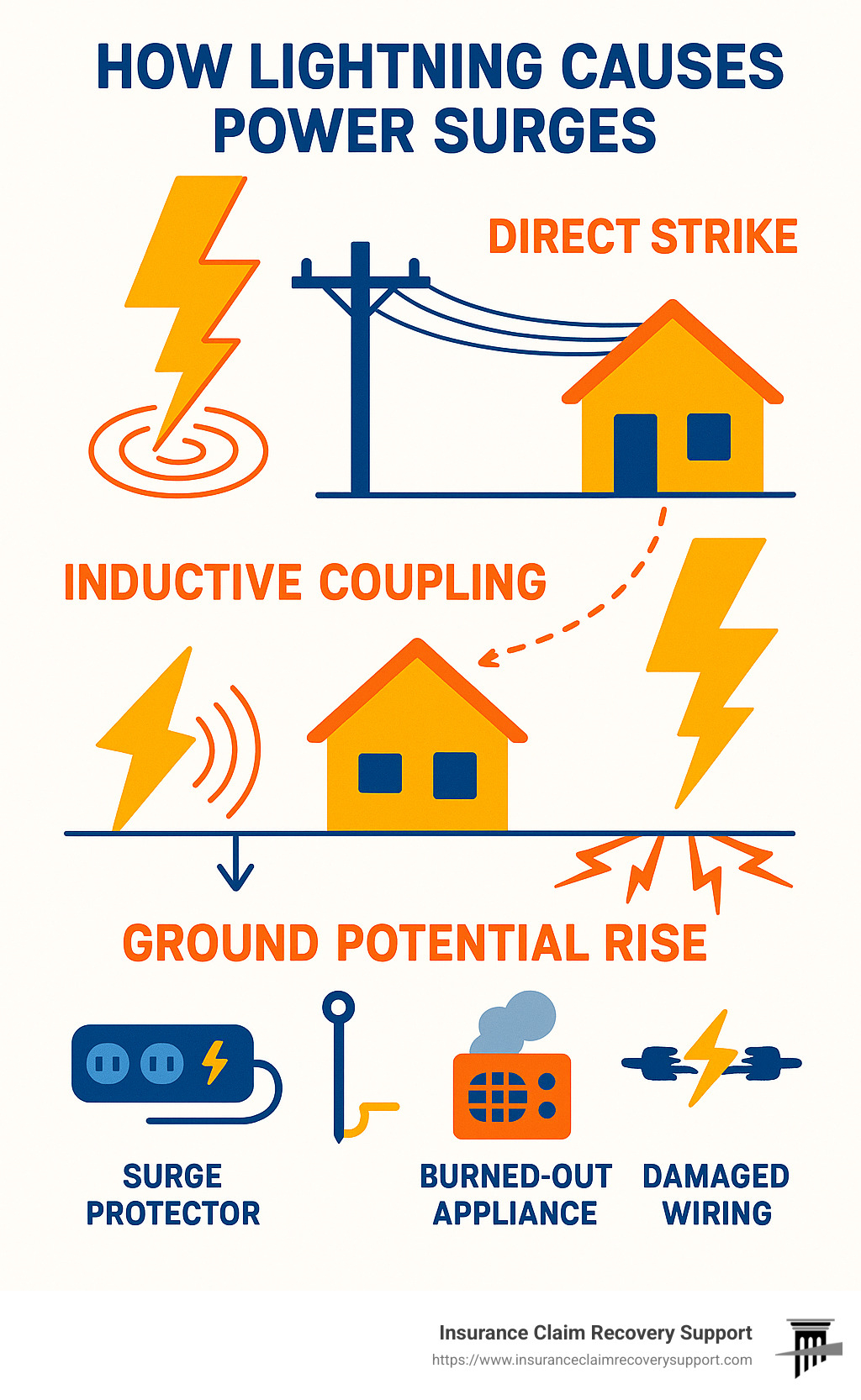
The damage from these surges can be immediate and obvious—fried circuit boards, melted plastic, or devices that simply won’t power on. But sometimes, the damage is more insidious. Lightning causing power surges can partially damage components, leading to failures that might not appear until weeks later. That expensive smart refrigerator that suddenly stops working in August might actually be suffering from damage sustained during a June thunderstorm.
While most standard homeowners insurance policies do cover lightning-induced power surges, proving the connection between a storm and your damaged electronics can be challenging without proper documentation. This is where having an experienced public adjuster becomes invaluable.
As a multi-state licensed public adjuster who has helped settle hundreds of claims related to electrical system damage, I’ve recovered millions for commercial building owners and homeowners associations across Texas. From Austin to Dallas, Houston to San Antonio, and everywhere in between, I’ve seen how proper claim handling makes all the difference in recovery.
The good news? With the right protection systems and knowledge, you can shield your home from these powerful natural events. In the following sections, we’ll explore exactly how these surges cause damage and the most effective ways to protect your property and handle insurance claims if the worst does happen.
How Is Lightning Causing Power Surges? Understanding the Basics
Picture this: a brilliant flash cuts across the dark Texas sky, followed by a thunderous boom. It’s nature at its most spectacular—but also potentially at its most destructive. When lightning strikes near your home, it’s not just putting on a show; it’s releaseing a powerful electrical force that can silently invade your property.
Lightning causing power surges happens in ways that many homeowners don’t fully understand until they’re dealing with damaged electronics. Let me break it down in simple terms: lightning carries an almost unimaginable amount of power—approximately 300 million volts and 30,000 amps. Compare that to your standard household outlet pushing just 120 volts and 15 amps, and you can see why lightning-induced surges are so devastating.
“When lightning strikes near a power line, the electrical energy can boost electrical pressure by millions of volts,” explains the National Weather Service. This massive power boost travels along any available conductor until it finds its way into your home’s electrical system.
There are three main ways lightning causes power surges in your Texas home:
-
Direct Strikes occur when lightning hits power lines or your home directly. Though these are the most destructive, they’re actually the least common scenario.
-
Inductive Coupling happens when lightning strikes nearby. Think of it like this: the lightning creates a magnetic field that “wirelessly” transfers energy into your home’s wiring—similar to how a wireless phone charger works, but with destructive rather than helpful energy.
-
Ground Potential Rise takes place when lightning hits the ground and the electrical energy travels through the earth, entering your home through underground wires, plumbing connections, or other conductive paths.
Here in Texas, our wide-open spaces and dramatic thunderstorms make homes particularly vulnerable. Whether you’re in Houston with its Gulf Coast storms, the sprawling metroplex of Dallas-Fort Worth, or the open plains around Lubbock and San Angelo, lightning causing power surges is a genuine threat to your property.
| Comparison | Lightning-Induced Surge | Everyday Power Surge |
|---|---|---|
| Voltage | Millions of volts | Few hundred volts |
| Duration | Microseconds | Milliseconds |
| Energy | Extreme | Moderate |
| Warning | None | Sometimes (flickering) |
| Frequency | Rare | Common |
| Damage | Often catastrophic | Usually cumulative |
What Is a Power Surge vs. a Lightning Strike?
It’s easy to confuse these terms, but understanding the difference helps explain how damage occurs:
A power surge is simply a spike in electrical voltage above the normal level. In your home, electricity flows in a sine wave pattern that peaks at about 169 volts. Anything significantly above that is considered a surge, which can come from many sources—including lightning.
A lightning strike, on the other hand, is the actual discharge of electricity from cloud to ground or other objects. Not every lightning strike will affect your home’s electrical system, but when it does, it creates one of the most powerful surges possible.
I remember speaking with a homeowner in Round Rock who thought her home was safe because lightning had struck “a good distance away.” She was shocked to find her TV, refrigerator, and HVAC system all damaged from the same storm. That’s the sneaky nature of lightning causing power surges—they don’t play by the rules we expect.
What makes lightning surges particularly dangerous is both their incredible power and their brief duration. While they might last only microseconds, that’s plenty of time to fry the delicate electronics we rely on daily.
Indirect Paths: Lightning Causing Power Surges Through Wiring and Antennas
Here’s where many homeowners get caught off guard: lightning causing power surges doesn’t need a direct hit to your home. In fact, most lightning-related damage comes through indirect paths:
Overhead Power Lines serve as perfect highways for lightning energy. A strike up to a mile away can send a destructive surge directly into your electrical panel. These exposed lines are especially vulnerable in open areas like Waco or Georgetown.
Buried Service Cables aren’t as safe as you might think. When lightning energizes the ground, that voltage can find its way into underground wiring.
Phone and Cable TV Lines often run parallel to power lines for miles. When lightning strikes nearby, these communication lines can carry surges directly to your internet router, television, or other connected devices.
Copper Plumbing may seem unrelated to your electrical system, but metal pipes can conduct electricity from a ground strike into your home through bonding connections.
Inductive Loops form when long runs of wiring inside your walls essentially become antennas, picking up electromagnetic energy from nearby lightning strikes.
As one forensic electrical engineer explained to me, “Lightning damage can occur even without a direct strike. The electromagnetic field alone can induce enough voltage in nearby conductors to destroy sensitive electronics.”
This explains why homes in neighborhoods like Lakeway or San Antonio might experience surge damage even when lightning struck several blocks away. The interconnected nature of our modern electrical systems means that lightning causing power surges can affect multiple homes from a single strike.
Understanding these basics helps explain why proper protection is so critical—and why documenting lightning-related damage properly can make all the difference when filing an insurance claim.
More info about surge entry points
Damage & Warning Signs You Can’t Ignore
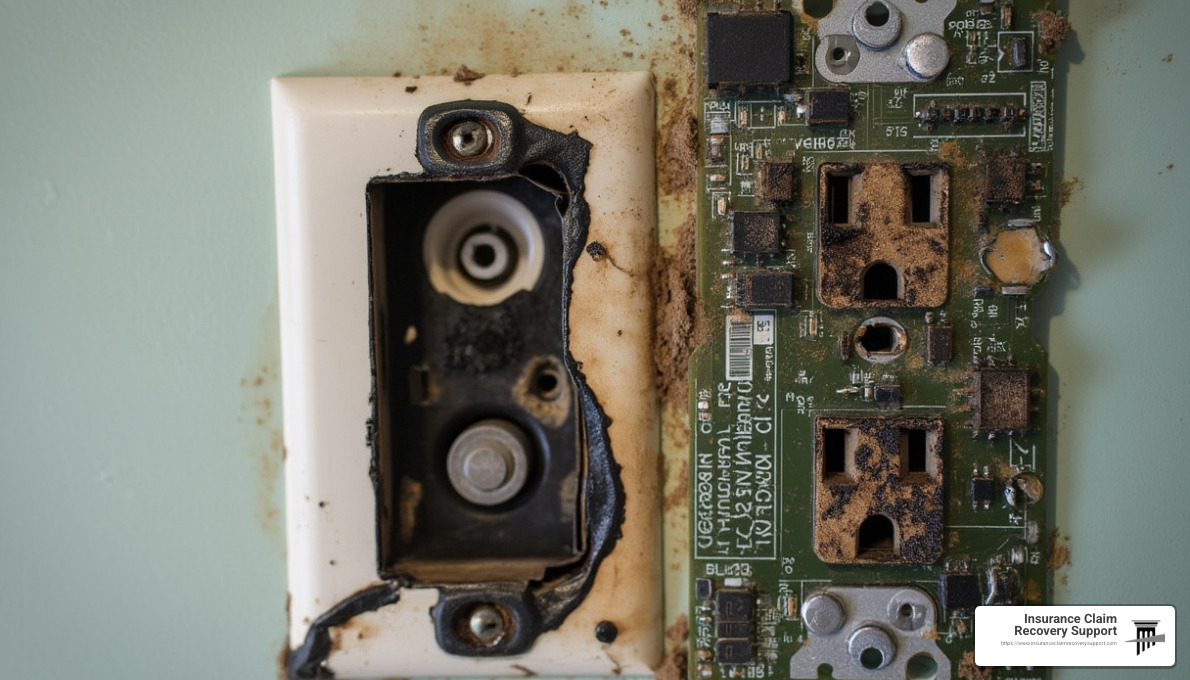
When lightning causing power surges invades your home, it leaves behind evidence of its destructive visit—sometimes obvious, sometimes cunningly hidden. I’ve seen homeowners in Austin and Dallas walk through their houses after storms, puzzled by why certain electronics no longer work, unaware of the electrical drama that unfolded during those brief flashes in the sky.
“Even a small power surge can fry sensitive components in modern electronics,” a power company technician once told me while investigating damage in a San Antonio neighborhood. “A large surge can overload circuits or cause electrical fires—and it happens faster than you can blink.”
According to research from the National Weather Service, lightning can generate up to a billion volts of electricity—a staggering amount of power that no standard home system is designed to handle. When this energy finds its way into your wiring, the results can be devastating.
Immediate Damage: From Vaporized Wires to Fried Circuit Boards
The dramatic, immediate signs of lightning causing power surges are hard to miss. After a powerful Texas thunderstorm rolls through, take a careful look around your home.
Charred insulation around wires and outlets often appears blackened or melted, especially near your home’s electrical entry points. You might notice blown MOVs (Metal Oxide Varistors)—those protective components in electronics that sacrifice themselves during a surge—looking cracked or discolored like small fallen soldiers.
Multiple tripped circuit breakers tell a story of their own. When several trip simultaneously, it’s nature’s way of waving a red flag that something powerful swept through your electrical system. Open your breaker panel (carefully!) and look for scorch marks—those small black smudges are electrical burns from extreme heat.
A Fort Worth homeowner shared her experience with me last summer: “After a lightning strike hit near our property, I noticed this strange buzzing sound coming from the kitchen. When I investigated, I found black marks around an outlet and my refrigerator plug had partially melted. The surge had traveled through the wiring and literally vaporized parts of the cord. It was terrifying to think what could have happened if we hadn’t been home.”
That distinctive burning odor of electrical components and melted plastic can linger for days after a serious surge. It’s not just unpleasant—it’s a warning sign that something has been damaged at a molecular level. And of course, the most obvious clue: non-functional electronics that worked perfectly before the storm but now sit lifeless despite your best troubleshooting efforts.
Look closely at metal connections for signs of arcing damage—those small burn marks where electricity jumped between conductors, leaving tiny craters in metal surfaces. These microscopic scars tell the story of electrical current that briefly took an unintended path.
Latent Effects: How Lightning Causing Power Surges Can Shorten Appliance Lifespan
Not all damage announces itself immediately—and this is what makes lightning causing power surges particularly treacherous. Some damage lies dormant, slowly developing over time like a time bomb in your electrical system.
Weakened insulation around wires might continue functioning but with compromised integrity. This creates future fire hazards as the insulation continues to degrade until a short circuit eventually occurs. Your home in Houston or Lubbock might seem fine for weeks before problems emerge.
Semiconductor degradation is perhaps the most common hidden damage. Those tiny transistors and integrated circuits in your smart devices may be partially damaged, causing them to function erratically or fail prematurely. Your expensive smart TV might work fine for a month after a storm, then suddenly develop strange glitches or dead pixels.
An electronics repair technician in San Angelo explained it perfectly: “We often see customers bringing in devices weeks or even months after a lightning storm. They’re confused because the device worked fine initially but gradually developed problems. What they don’t realize is that the lightning surge weakened components that continued functioning but were essentially living on borrowed time.”
Random reboots or glitches in electronics often signal surge damage. That smart thermostat that occasionally resets itself or the security system that triggers false alarms might be showing symptoms of a past electrical trauma. Your HVAC control system might work perfectly until the first hot day of summer when it suddenly fails completely.
I’ve seen weeks-later failures puzzle homeowners across Texas—from Waco to Round Rock and Georgetown to Lakeway. Their washing machine worked fine after the storm, only to die mid-cycle three weeks later. The connection often goes unmade, but the link is real.
Intermittent connection issues can be particularly frustrating. Damaged connectors or microscopic breaks in circuit board traces might cause sporadic problems that come and go, making diagnosis extremely difficult. Your router might drop connections only when it reaches a certain temperature, or your sound system might cut out only when playing bass-heavy music.
Circuit protection testing standards have actually been reduced “from 500 V to 250 V to avoid diode damage,” highlighting how even relatively modest surges can permanently impact today’s sensitive electronics. The days when electrical equipment could withstand significant power fluctuations are long gone—modern devices trade durability for efficiency and capability.
When lightning causing power surges visits your Texas home, it might leave immediately visible calling cards or subtle hints of its visit. Knowing what to look for helps you identify potential problems before they escalate into major failures or safety hazards. And if you do suspect surge damage, documenting everything thoroughly will be crucial if you need to file an insurance claim for lightning damage.
Protecting Your Property & Insurance Considerations
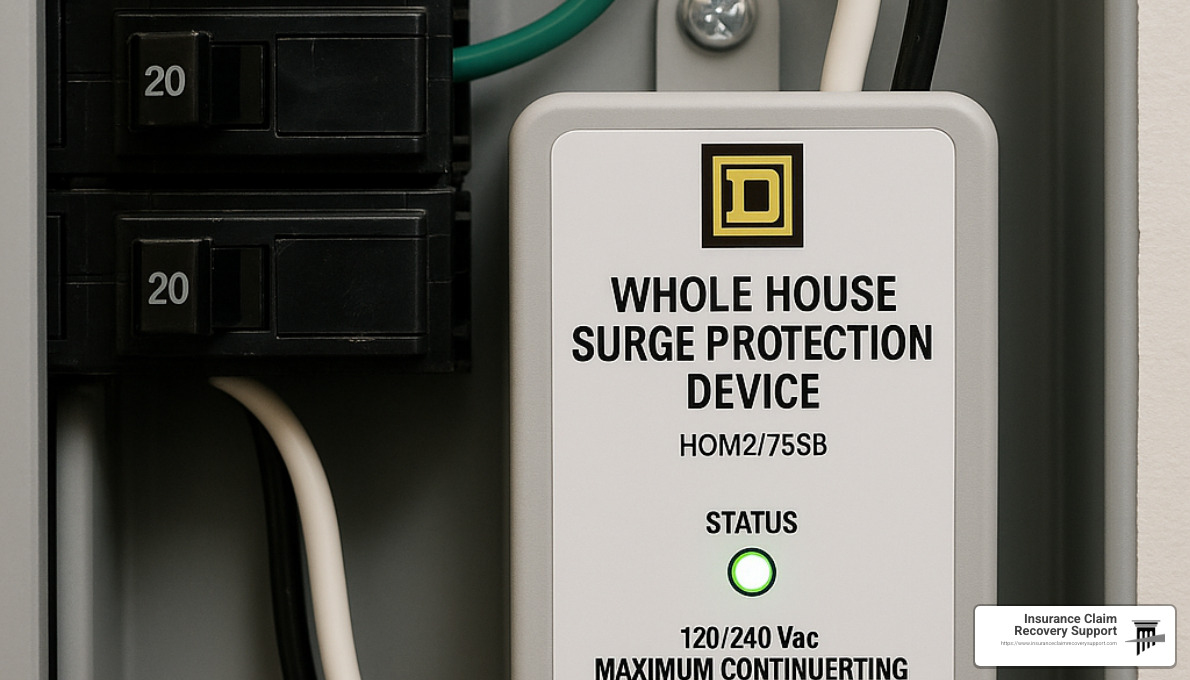
Living in Texas means accepting that thunderstorms are part of life. From the humid coastal regions of Houston to the flat plains around Lubbock, lightning causing power surges is a very real threat to your home’s electrical systems. The good news? You don’t have to leave your expensive electronics and appliances unprotected.
Layered Defense: Point-of-Use vs. Whole-House Surge Protection
When it comes to protecting your home from lightning-induced power surges, thinking in layers gives you the best chance of avoiding damage. Think of it like having multiple locks on your front door—each one adds another level of security.
Your first line of defense should be a whole-house surge protection device (SPD). These workhorses mount directly to your electrical panel and intercept incoming surges before they can spread throughout your home’s wiring. A good whole-house SPD follows UL 1449 standards as either Type 1 or Type 2 and can handle surges between 40,000 to 80,000 amps.
“I installed a whole-house surge protector after my neighbor lost three TVs and a refrigerator to a lightning strike,” shares Maria from San Antonio. “When lightning hit near my house last summer, I didn’t lose a single device. Best $300 I ever spent.”
These systems typically cost between $200-$500 installed by a licensed electrician—a small price compared to replacing multiple electronics or appliances.
But don’t stop there. The second layer should include point-of-use surge protectors for valuable electronics. Look for models with higher Joule ratings (ideally 2,000+ for entertainment centers and 1,000+ for smaller electronics). These plug-in protectors catch any surges that might slip past your whole-house system.
For your most critical equipment like home office computers or medical devices, consider adding an Uninterruptible Power Supply (UPS). These devices not only protect against surges but also provide battery backup during outages, allowing for safe shutdown of sensitive equipment.
No surge protection system, no matter how robust, can guarantee 100% protection against a direct lightning strike. However, a properly designed layered approach dramatically improves your odds against all but the most extreme events.
Grounding Essentials and Code Compliance
Even the best surge protector becomes nearly useless without proper grounding. Think of grounding as the escape route for excess electrical energy—without it, that energy has nowhere to go except through your electronics.
“I see it all the time,” explains Javier, an electrician serving the Austin area. “Homeowners install expensive surge protection systems but skip the grounding inspection. When lightning hits, the surge has nowhere to dissipate safely, and damage occurs despite their investment.”
Proper grounding means ensuring compliance with National Electrical Code Article 250, which specifies requirements for grounding and bonding. This includes connecting all grounding systems (electrical, telephone, cable, water pipes) together to create a unified ground plane. When these systems aren’t bonded together, voltage differences during a surge can actually create new paths for damage.
Texas presents unique grounding challenges in many areas. Parts of Round Rock, Georgetown, and other Hill Country locations have thin soil over limestone bedrock, which can increase soil resistivity and reduce grounding effectiveness. In these areas, specialized grounding techniques might be necessary.
I recommend having your home’s grounding system inspected annually by a qualified electrician, especially after any known lightning events nearby. They can check that your ground rods still maintain proper connection to earth and that all bonding conductors remain intact.
For homes in especially vulnerable locations (on hilltops or isolated areas), traditional lightning rods (air terminals) with dedicated down conductors might be worth considering as additional protection.
Navigating Insurance: Documenting Lightning Surge Losses
When lightning causing power surges damages your property despite your best preventive efforts, proper documentation becomes your best friend for insurance recovery.
Most homeowners policies cover lightning damage, but proving the cause and extent of the damage often requires thorough documentation. Insurance companies aren’t being difficult—they simply need evidence that lightning, rather than normal wear and tear or other excluded causes, damaged your property.
“The difference between a quick, full settlement and a denied claim often comes down to documentation quality,” notes Scott Friedson, founder of Insurance Claim Recovery Support. “Photos, timing evidence, and professional assessments make all the difference.”
After suspected lightning damage, start by photographing everything. Capture clear images of damaged items, especially any visible burn marks, melted components, or other obvious signs. These photos might be your most compelling evidence.
Next, obtain a lightning verification report that confirms lightning activity in your area at the specific time of the damage. Several weather services and specialized companies provide these reports, which can be crucial for substantiating your claim.
Create a detailed inventory of all affected items with make, model, purchase date, and replacement cost. Keep all damaged items until your claim is settled—your insurance adjuster may want to inspect them personally.
Obtain written assessments from qualified repair technicians that specifically note lightning or surge damage as the cause. These professional opinions carry significant weight with insurance companies.
We recently helped a Dallas homeowner whose entire smart home system was compromised by a lightning surge. The insurance company initially offered to replace only the visibly damaged components, which would have left an incompatible patchwork system. By providing comprehensive documentation and expert testimony about how surge damage affects integrated systems, we secured full replacement of the entire system—a difference of over $18,000 in the settlement.
For more information about maximizing your property damage claim, visit our detailed guide at More info about claim maximization.
Protection against lightning causing power surges requires both physical safeguards and proper insurance preparation. With both in place, you’ll be well-positioned to weather whatever electrical storms come your way.
Frequently Asked Questions about Lightning Causing Power Surges
Can appliances be damaged even if they’re turned off or unplugged?
Many homeowners are surprised to learn that their appliances aren’t completely safe just because they’re switched off or even unplugged during a storm. The truth is a bit more complicated – and concerning.
Modern appliances with standby circuits are particularly vulnerable. That “off” button on your smart TV or gaming console doesn’t actually disconnect it from power – it simply puts the device into a low-power state where it’s still connected to your home’s electrical system. These standby circuits remain completely exposed to any surge that enters your home.
Even more surprising, devices with external connections can be damaged without being plugged into power at all. As one electronics technician I spoke with explained:
“I’ve seen cases where a TV was unplugged but still connected to a cable line. Lightning hit near the cable company’s equipment, traveled through the coaxial cable, and damaged the TV’s input circuitry—even though it wasn’t connected to power.”
The truly frightening aspect is induced voltage. During powerful lightning strikes, the electromagnetic fields generated can actually induce electrical currents in unplugged cords if they’re still near other wiring. It’s like a wireless charging pad for your phone, but with destructive levels of power.
For folks in storm-prone areas like San Angelo or Amarillo, where thunderstorms can be particularly violent, the safest approach during severe weather is disconnecting all connections – power, cable, phone, and internet – from your valuable electronics. It’s a small inconvenience that could save you thousands in replacement costs.
How can I tell lightning damage from a typical power surge?
Distinguishing between damage from lightning causing power surges versus everyday electrical fluctuations can be tricky, but there are telltale signs that can help you identify the culprit.
When lightning is the cause, you’ll typically notice multiple devices affected simultaneously across different circuits in your home. The damage appears suddenly after a thunderstorm, not gradually over time. You might spot visible charring or burning, especially at entry points like your electrical panel or where utilities enter your home. External components like satellite dishes, outdoor lighting, or HVAC units are often affected too. And here’s a big clue – your neighbors might report similar issues after the same storm.
Regular power surges, on the other hand, usually damage devices on just a single circuit. The deterioration happens gradually as components weaken over time. These issues often correlate with grid switching or when large appliances like air conditioners cycle on and off, and they typically have no connection to weather events.
A forensic investigator I consulted who specializes in electrical claims explained their process: “We examine onsite indicators like arcing, soot deposits, structural damage, and cross-reference with weather data and lightning verification reports.”
These lightning verification reports are particularly valuable for insurance claims, as they can confirm with remarkable accuracy (over 99%) whether lightning struck near your property at a specific time. For homeowners in Texas cities like Austin or Houston, where summer thunderstorms are common, these reports can make the difference in getting your claim approved.
Do surge protectors guarantee protection from lightning?
I wish I could tell you that buying a good surge protector means you never have to worry about lightning causing power surges again. Unfortunately, that would be misleading.
The hard truth is that no surge protector on the market can fully protect against a direct or very close lightning strike. As one electrical safety expert bluntly put it: “In a lightning storm, you should never rely on your surge protector to save your electronics. No surge protector can handle the full force of a direct lightning strike.”
The math simply doesn’t add up in your favor. Most consumer-grade surge protectors are designed to handle surges of a few thousand volts, while lightning can deliver millions. They can be completely overwhelmed by the extreme energy of a nearby strike. And once they’ve absorbed their rated amount of energy (measured in joules), they provide no further protection – often without any visible indication they’ve failed.
Even whole-house surge protection devices installed at your electrical panel have their limits when facing lightning’s raw power. One manufacturer honestly admitted: “Surge protectors can guard against high-voltage surges but do not prevent damage from a direct lightning strike.”
Your best defense is a layered approach that combines:
1. A whole-house surge protector at your electrical panel
2. High-quality point-of-use surge protectors for valuable electronics
3. Physically unplugging critical or expensive devices during severe storms
This strategy won’t guarantee complete protection from a direct strike, but it dramatically improves your odds of avoiding costly damage. For folks in lightning-prone areas of Texas like Dallas-Fort Worth or San Antonio, this layered protection isn’t just sensible – it’s essential.
Conclusion
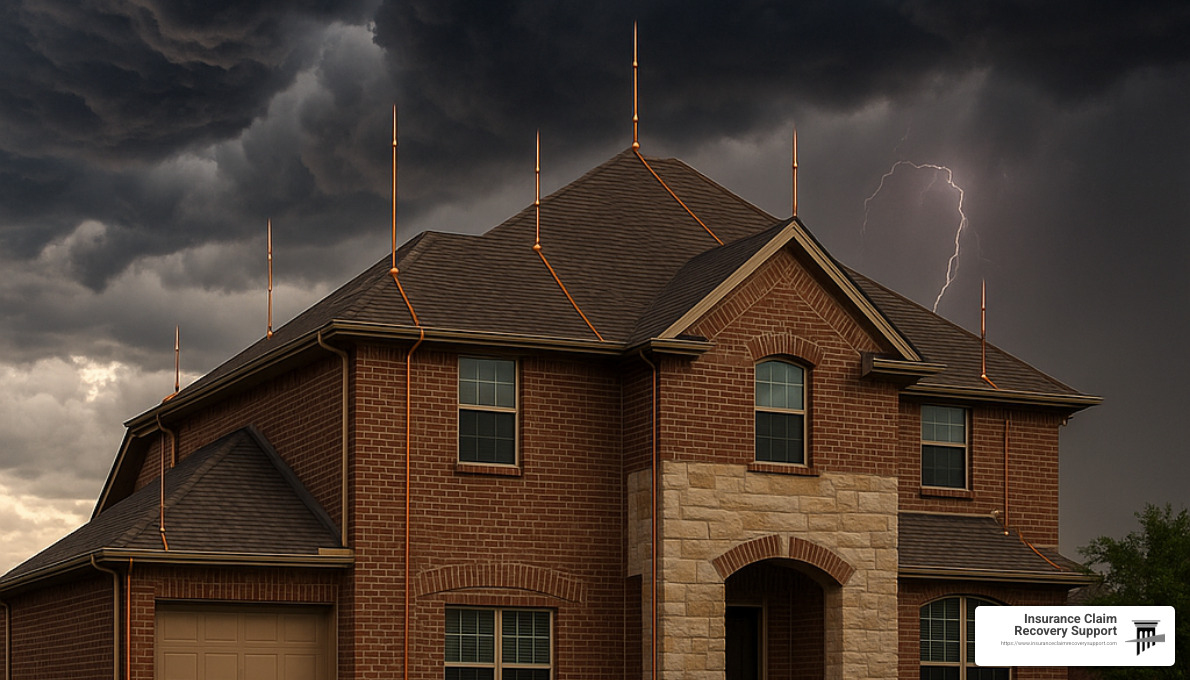
When lightning dances across the Texas sky, it creates more than just a spectacular light show—it poses a genuine threat to your home’s electrical system and everything connected to it. Throughout this article, we’ve explored how lightning causing power surges can wreak havoc on your property, from catastrophic immediate damage to those sneaky delayed failures that might not show up until weeks later.
Living in storm-prone Texas means we’re particularly vulnerable to these powerful natural events. Whether you’re in a high-rise in downtown Dallas, a ranch house outside San Angelo, or a suburban home in Round Rock, lightning doesn’t discriminate. The good news? You now understand how these surges work and how to protect your property.
Your best defense is a thoughtful, layered approach to protection. Start with a whole-house surge protector installed by a qualified electrician—think of it as your first line of defense against the millions of volts that lightning can deliver. Add quality point-of-use surge protectors for your valuable electronics, paying attention to those Joule ratings (higher is better). For extra peace of mind, especially during those dramatic summer thunderstorms, simply unplug your most expensive devices.
Proper grounding is absolutely essential. Without it, even the best surge protection devices can’t do their job effectively. If your home is older or you haven’t had your electrical system inspected recently, consider having a professional check your grounding system—it’s a relatively small investment that could save you thousands.
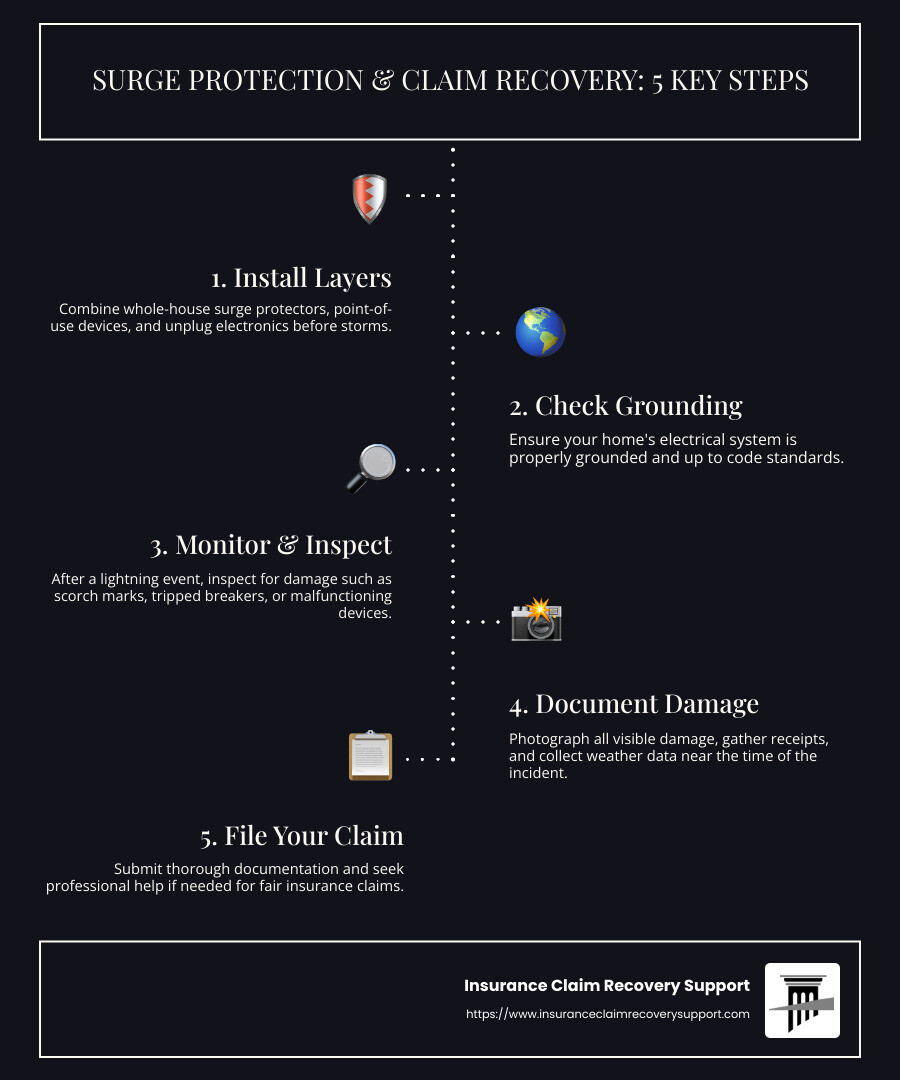
If the worst happens and lightning causing power surges damages your property, documentation becomes your best friend. Take clear photos of all damaged items. Keep a detailed inventory of what was affected. Save receipts for repairs or replacements. And consider getting a lightning verification report to confirm storm activity in your area—this can be incredibly valuable when filing your insurance claim.
Here at Insurance Claim Recovery Support, we’ve helped countless Texans steer the complicated aftermath of lightning damage. We’ve seen everything from fried circuit boards in Georgetown mansions to damaged HVAC control systems in Houston high-rises. As public adjusters who exclusively represent policyholders (never insurance companies), we understand both the technical aspects of lightning damage and the ins and outs of the claims process.
While most homeowners insurance policies cover lightning damage, proving what happened and securing fair compensation often requires specialized knowledge. That’s where we come in. Our team of experienced public adjusters serves communities across Texas—including Austin, Dallas, Fort Worth, San Antonio, Houston, Lubbock, Waco, and beyond—helping homeowners recover what they’re entitled to under their policies.
Don’t face the insurance company alone after experiencing lightning causing power surges. Contact Insurance Claim Recovery Support for a free consultation, and let us help you weather the storm of the claims process while you focus on getting your home back to normal.
Want to learn more about protecting your property? Check out our detailed guide on whether homeowners insurance covers lightning strike damage for additional insights.






